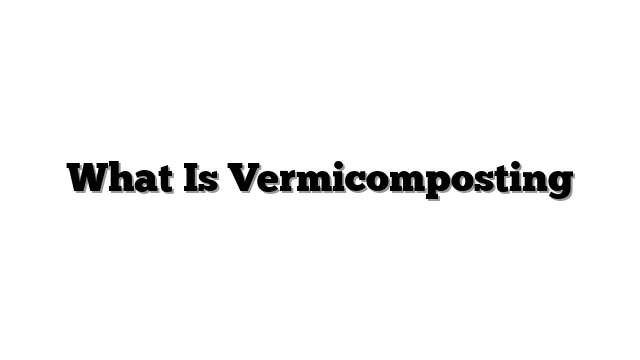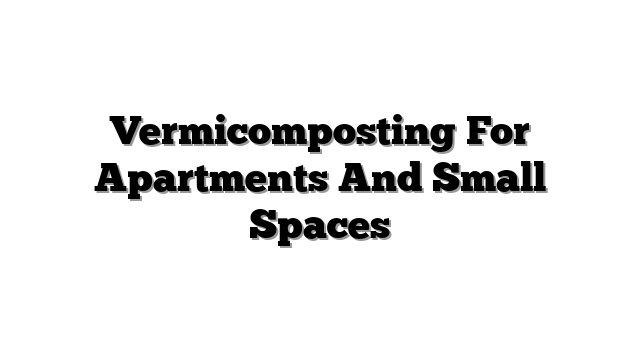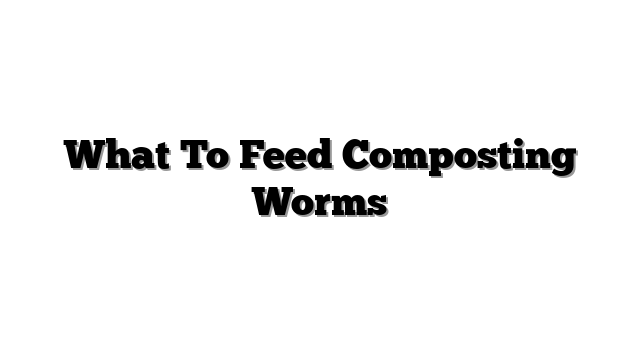What Is Vermicomposting
Your garden soil feels tired. Plants struggle to grow strong. You use chemicals. Maybe you toss food scraps daily. You feel a bit guilty. There is a better way. We can make our own plant food. It is a natural process. Worms do all the work. This is vermicomposting. It means composting with worms. It is a powerful method. It helps soil. It cuts waste. It is sustainable gardening. This guide helps you learn. What is vermicomposting? We cover everything. We show you the process. You will learn setup. Care for your worms. Harvest your garden gold. We talk about using it. Get ready for better soil. Prepare for healthier plants. Let’s start your journey.
Understanding the Magic: What Exactly Is Vermicomposting?
Vermicomposting is composting. It uses special worms. They eat organic waste. Worms turn it into castings. These castings are rich. They are like super soil. It is a natural process. Microbes help the worms. They break things down faster.
The stars are the worms. Not just any worm works. We need composting worms. Red Wigglers are the best. Their scientific name is Eisenia fetida. They eat waste quickly. They live well in bins. They also reproduce fast. Other worms work too. European Nightcrawlers are an option. But Red Wigglers are number one. They are easy to find.
How does it work? You give worms bedding. This is their home. You add food scraps. Worms eat the bedding. They eat the food scraps. They digest everything. Then they excrete castings. These castings are nutrient-rich. Microbes in the bin help. They break food down first. Worms eat the microbes. They eat the softened food. It is a team effort.
Compare it to regular composting. Vermicomposting is much faster. You can do it inside. It needs less space. The final product is richer. Castings are better than compost. There is less smell too. This is true if you manage it well. It is perfect for kitchen scraps.
The benefits are amazing. Gardeners love worm castings. They are a superior soil helper. Castings have many nutrients. They release slowly. They have good microbes. Soil structure gets better. Soil holds water better.
Vermicomposting cuts waste. It supports sustainable living. We recycle food waste. It avoids landfills. This is food waste recycling. It saves you money. You make your own fertilizer. It is eco-friendly. No synthetic chemicals needed. It is organic gardening. Castings help plants fight pests. They resist diseases naturally. This improves plant health.
“Worm castings are soil food,” says soil scientist Dr. Anya Sharma. “They feed the microbes. The microbes feed the plant.” A recent study in 2024 showed this. Plants grown with castings were stronger. They had fewer pest problems.
Keywords: What Is Vermicomposting?, worm composting, organic gardening, sustainable gardening, soil health, worm castings, red wigglers, food waste recycling, vermicomposting benefits.
Setting Up Your Vermicomposting System: Bin & Bedding
Time to build a worm home. You need a bin. Many kinds exist. Plastic bins are simple. They hold moisture well. Wooden bins breathe better. They look nice too. Multi-tray systems stack up. They make harvesting easy.
You can buy a bin. Or make one yourself. Store-bought bins work well. DIY bins save money. Just ensure two things. Drainage is essential. Holes let extra water out. Ventilation is also key. Airflow prevents bad smells. It stops anaerobic conditions. This is important for troubleshooting vermicomposting later.
Bin size matters. How much waste do you have? Estimate kitchen scraps weekly. A small family needs less space. Maybe a 10-gallon bin. A large family needs bigger. Maybe a 20-gallon bin. Worms eat half their weight daily. That is a good rule.
Where will the bin go? Indoors is a good choice. Basements work well. Garages or kitchens too. Temperatures stay steady. This helps indoor composting. Think about space. Some minor smell is possible. Outdoors is another option. A shed is good. A sheltered spot works. You get more space outside. Watch temperature extremes though. Worms need stable warmth. Insulate the bin in winter. Give it shade in summer.
Now prepare the bedding. This is the worm’s house. It is their first meal. Bedding is the carbon source. Shredded newspaper works well. Avoid shiny paper. Shredded cardboard is great. Corrugated is best. Coconut coir is another choice. Aged compost is good too. Straw also works.
Prepare the bedding right. Shred materials into strips. Moisten them with water. How wet? Like a wrung-out sponge. Squeeze a handful tight. Only a drop or two should fall. This moisture is vital. It keeps worms healthy. It prevents problems.
Add a bit of soil. A handful is enough. Soil has grit. It helps worms digest food. Worms have no teeth. Grit grinds food inside.
Get your worms ready. Buy them online. Find a local worm farm. Ask a gardening friend. How many worms? It goes by weight. It depends on bin size. It depends on your waste. One pound is a good start. This is about 1000 worms. Gently add worms to bedding. Let them settle in. Give them a day or two. Then add a little food.
Keywords: How to start vermicomposting, Vermicomposting bin setup, Best worms for vermicomposting, Indoor composting, Red wigglers, Bedding for worm bin, Worm bin maintenance.
Feeding Your Worms: What’s on the Menu?
Worms need food. They eat your kitchen scraps. But not all scraps are good. Let’s see what they like.
Good foods include fruit peels. Vegetable scraps are great. Coffee grounds are a favorite. Filters are okay too. Tea bags work (remove staples). Crushed eggshells are helpful. They add calcium. They add grit. Plain paper is food. Cardboard is food. Tear it into small pieces. Bread and grains are okay. Feed these in small amounts.
Why are these good? Worms digest them easily. They give balanced nutrients.
Some things are bad for worms. Never add meat. No dairy products. Avoid oily foods. These attract pests. They cause bad smells. Citrus fruits can be bad. They make the bin too sour. Do not feed spicy foods. No pet waste ever. Diseased plants are a no. No glossy paper. No plastic. No metal. No glass.
Why avoid these? They attract pests. They cause bad smells. They create bad conditions. They hurt the worms. They do not break down.
Prepare food first. Chop big pieces small. This speeds up eating. Worms eat edges first. Smaller pieces have more edges. You can freeze scraps. Then thaw them. This breaks cell walls. Worms eat them faster. It is not required.
How and when to feed? Start small with new worms. Do not give too much food. Bury the food scraps. Dig a little hole. Put food in the hole. Cover it with bedding. Why bury food? It stops fruit flies. Worms find it better. Rotate where you bury food. Use different spots each time.
How often do you feed? It depends on the worms. Watch how fast they eat. If food is gone, add more. If food piles up, stop. This means you feed too much. Overfeeding causes smells. Worms tell you what they need. Pay attention to them.
Keywords: What to feed vermicomposting worms, Kitchen scraps, Food waste recycling, Feeding worms, Worm bin maintenance, Troubleshooting vermicomposting problems.
Maintaining a Happy Home: Moisture, Airflow, and Temperature
Worms need a good home. Happy worms work best. They need certain conditions. Keeping conditions right prevents problems.
Moisture is very important. Worms breathe through their skin. Their skin must stay wet. The bin needs moisture. It should not be too wet. It should not be dry. Think of a wrung-out sponge. This is the right moisture. Squeeze bedding in your hand. A drop or two of water is okay. More water is too much.
How to fix moisture? Add dry bedding if too wet. Use shredded paper or cardboard. Mix it in. Sprinkle water if too dry. Use a spray bottle.
Airflow is also crucial. Worms need air. The bin needs air. This prevents bad smells. It stops anaerobic conditions. These conditions hurt worms. Gently turn the bedding. Use a small trowel. Or use your hands. Do this once or twice a week. Do not disturb worms too much. Just fluff the material.
Temperature matters a lot. Red wigglers like it warm. Not too hot. Not too cold. The best range is 15-25°C. That is 59-77°F. Freezing temperatures kill worms. Very hot temperatures kill them.
Manage temperature extremes. Keep bins indoors in winter. Or insulate outdoor bins well. Put outdoor bins in shade. This helps in summer heat. Add frozen water bottles in hot bins. This cools things down fast.
Sometimes problems happen. Troubleshooting vermicomposting is easy. Bad smells are common. This usually means too wet. Or not enough air. Or you fed wrong food. Add dry bedding. Gently turn the bin. Remove offending food.
Pests can appear. Fruit flies are annoying. They like exposed food. They like wet bins. Bury all food. Add dry bedding. You can use traps. Mites are small bugs. They are mostly harmless. Too many mites? Bin might be too wet. Add dry bedding. Improve air flow. Ants mean the bin is dry. Add more moisture.
Worms try to escape sometimes. This is a bad sign. Conditions are not right. Is it too wet? Too dry? Too hot? Too cold? Is there bad food? Did you just add them? Check everything. Fix the problem. Worms will stay put. Worms dying is serious. This means extreme conditions. Fix temperature or moisture quickly.
Keywords: Troubleshooting vermicomposting problems, Worm bin maintenance, Indoor composting, Worm health, Aeration in worm bin, Vermicomposting smell, Worms escaping bin.
Harvesting Your Treasure: Collecting Worm Castings
Your hard work pays off. The worms finish their job. You get worm castings. This is your garden treasure.
How do they look? Finished castings are dark brown. They are almost black. They are crumbly. They smell like fresh earth. You see no old food scraps. It is a rich, dark material.
How long does it take? The first harvest takes time. Maybe 3 to 6 months. It depends on many things. Bin size matters. How many worms you have matters. How much you feed matters. After the first time, it is faster. You can harvest every 1 to 3 months.
You need to separate worms. You want the castings only. Several methods work. Migration methods are popular. They are easy for home bins.
Try the side-to-side method. Stop feeding the whole bin. Feed only one side now. Add new bedding there. Worms move to the food. They leave the finished side. After a few weeks, harvest the empty side. Scoop out the castings. Put any worms back.
The top-harvest method works too. Stop feeding the bin. Let the top layer dry a little. Place new food and bedding on top. Worms move up to eat. They leave the lower layers. Harvest the bottom part.
Screen sifting is another way. Empty the bin onto a screen. Use a screen with small holes. Castings fall through. Worms and big bits stay on top. This needs more work. It gives cleaner castings.
Batch harvesting is simple. Empty the whole bin. Pick out the worms by hand. Put worms back in the bin. Use the rest as castings. This is good for small bins. Or when you restart a bin.
Separate worms carefully. Use light to help. Worms hate light. Shine a light on the pile. They will move down. Scoop off the top layer. Repeat until you see many worms. Put worms back in the bin.
Store your castings well. Let them dry a little first. Put them in a bag. Use a breathable bag. Store them in a cool place. Keep them dark. Castings lose some microbes. This happens over time. But they still work great. They are still a good fertilizer.
Keywords: Harvesting worm castings, Using vermicompost, Worm castings, Nutrient-rich soil, Soil improvement.
Putting Worm Castings to Work: Supercharging Your Garden
You have the “black gold.” What do you do now? Worm castings are amazing. They make plants happy.
Why are they so good? They have many nutrients. The nutrients are balanced. They release slowly into soil. Castings are full of microbes. These microbes help plant roots. They improve soil structure. Soil gets more air. It holds water better. Castings help seeds sprout. They boost plant health. They help fight plant diseases.
Castings are different from compost. They are finer material. They are more powerful. They have more microbes.
How can you use them? Many ways exist. Mix them into garden beds. Do this before planting. Add them to pots. Use about 10% to 20% of soil volume. This helps soil amendment.
Put them on top of soil. This is called top dressing. Sprinkle a layer around plants. Do this for indoor plants. Do it for outdoor plants. Water makes nutrients release. It is a slow feed.
Make compost tea. This is liquid fertilizer. Steep castings in water. You can bubble air through it. This makes aerated tea. Or just let it sit. Use this tea on soil. Water your plants with it. You can spray leaves too. This is called foliar spray.
Use castings for seeds. Add a small amount. Mix it into seed starting mix. It gives seedlings a boost. This helps gardening for beginners.
Mix castings into potting soil. Use it for container plants. Your potted plants will love it.
You do not need a lot. Castings are strong. Use them carefully. Follow general rules. A little goes a long way.
All plants benefit. Vegetables grow stronger. Flowers bloom brighter. Herbs taste better. Houseplants look healthier.
Using your own castings connects things. You use your kitchen waste. You feed your garden. It promotes sustainable gardening. It supports sustainable living. It closes the loop nicely.
“Castings are the best amendment,” says local gardener Tom Lee. “My plants never looked better.” A recent survey showed this. Gardeners using castings reported bigger harvests. They saw fewer sick plants.
Keywords: Using worm castings, Worm castings benefits, Soil health, Organic gardening, Plant health, Nutrient-rich soil, Gardening for beginners, Vermicomposting benefits.
FAQs
People ask questions about worms. Here are common ones.
Does vermicomposting smell? No. Not if done right. A healthy bin smells earthy. Like soil after rain. Bad smells mean problems. Usually it is too wet. Or not enough air. Or bad food went in. Fix the conditions. The smell goes away.
How long for castings? The first time takes longer. Maybe 3 to 6 months. Then you get more often. Maybe every 1 to 3 months. It depends on your bin. It depends on your worms. It depends on feeding.
Can I use any worm? No. You need special worms. Composting worms are needed. Red Wigglers are best. They eat waste fast. Earthworms do not work well in bins. They live deep in soil.
Worms try to escape. Why? Something is wrong. Check moisture levels. Check air. Check the temperature. Did you add bad food? Is the bin too full? Find the problem. Fix it. Worms will stay.
Can I keep the bin outside? It depends where you live. Worms need stable temperatures. Extreme heat or cold kills them. In mild climates, yes. In cold places, move it inside. Or insulate it very well.
Keywords: Worm composting questions, Vermicomposting smell, How long does vermicomposting take, Best worms for composting, Worms escaping bin, Outdoor worm bin.
Conclusion
We learned about vermicomposting. What is vermicomposting? It is using worms to compost. It turns waste into treasure. This treasure is worm castings. It has amazing benefits. You reduce waste. You improve soil health. Your plants grow strong. It is easy to start. You need a bin. You need bedding. You need red wigglers. Feed them the right food. Keep their home happy. Manage moisture and air. Watch the temperature.
Harvest your castings. Use them in your garden. Mix them in soil. Put them on top. Make a liquid tea. It is a simple process. It is very rewarding. It works for any gardener. You do not need much space. Turn kitchen scraps into gold.
This is sustainable gardening. It is sustainable living. Start your own bin. It helps you. It helps your garden. It helps the planet. Learn more here. Share your worm stories. Find other guides on our site. Your plants will thank you.







